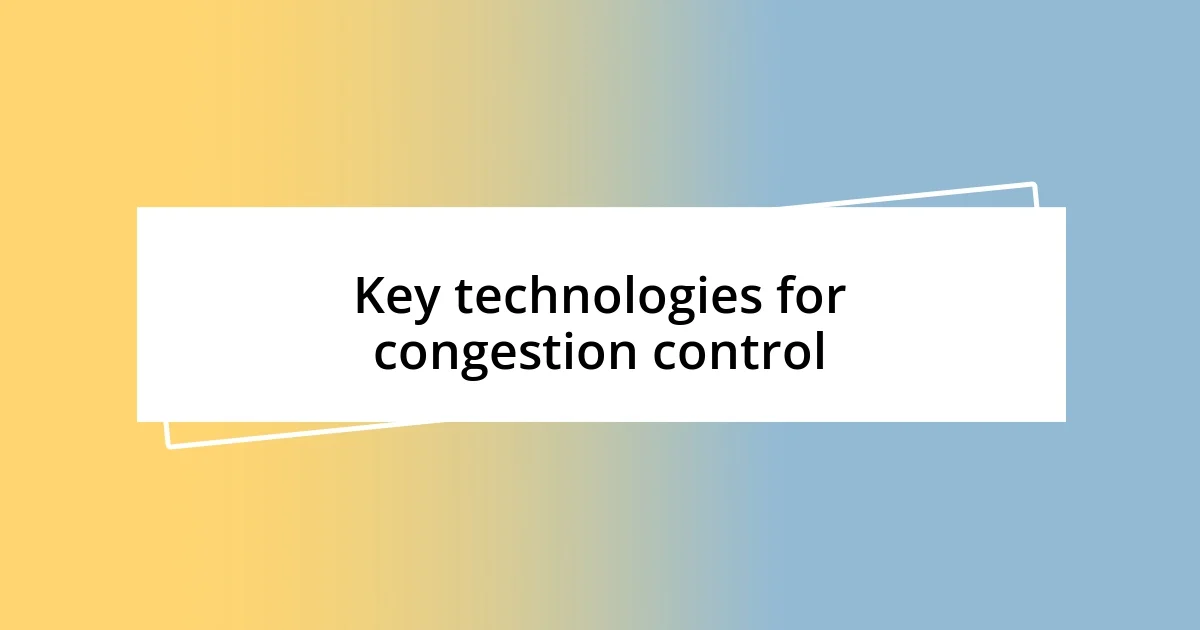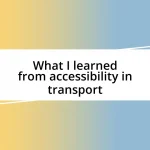Key takeaways:
- Congestion management technologies, like smart traffic signals and real-time monitoring systems, enhance traffic flow and reduce emissions, leading to a more efficient and environmentally friendly commuting experience.
- Real-time data analysis empowers drivers with live traffic updates, allowing for informed routing decisions and significantly improving their overall travel experience.
- The future of congestion management includes advancements in AI, autonomous vehicles, and multimodal transportation systems, promising smoother travel experiences and better urban planning.

Understanding congestion management technologies
Congestion management technologies are fascinating tools designed to alleviate traffic bottlenecks and improve the flow of vehicles. I often think about how frustrating it can be to sit in bumper-to-bumper traffic, wondering if there’s a better way. These technologies include smart traffic signals, real-time traffic monitoring systems, and adaptive traffic control, all of which work together to create a more efficient driving experience.
When I recall my own experiences on crowded highways, I can’t help but appreciate the potential of these technologies. Imagine a world where traffic signals adjust dynamically based on real-time conditions—how much time would we save? Not only do these systems reduce congestion, but they can also lower emissions, making our roads more environmentally friendly.
Another interesting aspect is the data-driven approach behind these systems. The use of big data allows for predictive analytics, which can foresee traffic patterns and address issues before they escalate. Have you ever wondered how a small change in your route can make a significant difference in travel time? Well, congestion management technologies can provide those insights, leading to a more informed and enjoyable journey.

Importance of congestion management
Effective congestion management is crucial for enhancing overall transportation efficiency. I remember a time when my commute was routinely marred by long delays and unpredictable traffic patterns. After a few frustrating mornings spent sitting in my car simply waiting, it became clear to me how imperative it is to adopt modern solutions that ease these types of issues. Not only does managing congestion allow for smoother travel, but it also leads to reduced stress for drivers.
- Minimizes travel time and enhances productivity.
- Decreases fuel consumption and lowers greenhouse gas emissions.
- Improves road safety by reducing the likelihood of accidents caused by traffic backups.
- Increases the reliability of public transportation systems.
- Facilitates economic growth by ensuring efficient movement of goods and services.
I find it fascinating how employing these technologies can transform our daily lives. Just the other week, I experienced a new adaptive traffic signal in my neighborhood. It was remarkable to see how seamlessly it adjusted to the flow of traffic, easing my commute just when I needed it most. Effective congestion management doesn’t just fix problems; it fosters a more enjoyable and predictable travel experience.

Key technologies for congestion control
One of the key technologies I often think about is smart traffic signaling. These systems utilize sensors to gather real-time data about traffic flow, allowing signals to adapt accordingly. I still remember the relief I felt when I first encountered these signals; instead of waiting at a red light while no cars were coming, I saw the light change smoothly. It not only saved me time but also made me feel like the system was working for me rather than against me.
Another exciting advancement is real-time traffic monitoring and management systems. These technologies provide crucial information about road conditions, allowing drivers to make informed decisions. I recently downloaded a traffic app on my phone that alerted me to heavy congestion ahead, enabling me to reroute my trip. It was a game-changer! I couldn’t help but think how important these systems are for getting where we need to go without unnecessary delays.
Lastly, adaptive traffic control systems take things a step further by adjusting traffic signals based on predicted demands. When I think about my old commute through a dense urban area, I realize how much anxiety could have been avoided if these systems had been in place. They can be a lifesaver on particularly busy days, reducing both frustration and fuel consumption by optimizing the flow of vehicles.
| Technology Type | Description |
|---|---|
| Smart Traffic Signals | Signals that adapt in real-time based on traffic flow. |
| Real-Time Traffic Monitoring | Systems providing live updates on road conditions and congestion. |
| Adaptive Traffic Control | Adjusts traffic signals based on predicted traffic demands. |

Benefits of real-time data analysis
Real-time data analysis offers a treasure trove of insights that can dramatically enhance our commuting experience. I vividly remember a day when my navigation app guided me away from a traffic jam—the app’s live updates literally saved me an hour. Wouldn’t it be wonderful if every journey could be that seamless? With real-time data at our fingertips, we can make smarter choices on the road.
The emotional relief that comes from knowing I can trust these technologies is immense. There’s something empowering about traveling with live traffic information; it removes the uncertainty. For instance, when I was stuck in gridlock during a thunderstorm, receiving real-time alerts about alternative routes felt like having a personal traffic assistant. It made the journey not just manageable but bearable, turning what could have been a stressful situation into a controlled experience.
Moreover, the benefits extend beyond individual drivers. Think about city planners—how much easier is it for them to allocate resources effectively when they can analyze data in real time? I once attended a town hall meeting where officials discussed using traffic data to pinpoint where new bike lanes were most needed. Seeing the community engage with this information was inspiring. It’s a reminder that real-time data analysis doesn’t just enhance our travels; it shapes the future of our cities.

Role of smart traffic signals
Smart traffic signals are truly one of the most fascinating technologies I’ve encountered. I remember driving through a busy downtown area and noticing how the signals seemed to sense the ebb and flow of vehicles. Instead of the usual waiting games where I’d tap my fingers on the steering wheel, the lights changed just when I needed them to. It felt as if the system understood my urgency, a small yet significant comfort in the hustle and bustle of urban life.
These signals aren’t just about convenience; they also play a critical role in safety. I’d like to share an experience where I witnessed an emergency vehicle needing to navigate through heavy traffic. Thanks to smart signals, the intersection cleared instantly, allowing the vehicle to reach its destination without delay. In a real-world scenario, the difference these signals can make in emergencies can be life-saving. Can you imagine being in a situation where every second counts, and a smart system works seamlessly in the background to help?
Additionally, there’s something revolutionizing about how these signals analyze real-time data. They can adjust timing based on current conditions, making it less likely for me to encounter frustrating gridlocks at peak times. I often think back to those frustrating days of being stuck in traffic, yearning for a smarter system. With smart traffic signals in play, the future of our roads looks promising, not just for commuters like me, but for the overall traffic flow in our cities. Wouldn’t you agree that such advancements are something we can all look forward to?

Future trends in congestion management
The future of congestion management is undeniably exciting with advancements in artificial intelligence (AI) and machine learning. I recall a seminar where experts demonstrated how AI can predict traffic patterns days in advance. Just imagine being able to plan your route knowing what traffic might be like not just today, but potentially tomorrow or even next week! It’s like having a crystal ball that helps minimize delays before they even happen.
Moreover, the integration of autonomous vehicles is poised to revolutionize our approach to traffic control. I remember discussing with a friend the implications of self-driving cars communicating with infrastructure in real time. The thought of these vehicles working harmoniously to optimize traffic flow made me realize how much less stressed I might be during my daily commutes. Wouldn’t it be refreshing to think about traffic not as a hurdle but as a smooth drive?
Additionally, I see a growing trend in multimodal transportation systems, which blend various transportation methods seamlessly. Last summer, I used an app that suggested combining bike-share options with public transit for my trip across town. The thrill of trying out different transportation modes not only reduced congestion but also allowed me to enjoy my surroundings in a way that driving alone never could. How wonderful it would be if more cities embraced this integrated approach, transforming our travel experiences while tackling congestion head-on!

Implementing technologies in urban settings
Implementing technologies in urban settings requires a thoughtful approach that accounts for the unique challenges of city life. I recall a time when we introduced smart parking systems in my neighborhood. The initial skepticism among residents was palpable; many wondered if these technologies would really make a difference. Yet, as we saw less frustration over finding parking spots, it became clear that smart systems can directly enhance our daily experiences.
As cities adopt real-time data analytics, I have witnessed the positive impact on traffic flow and urban planning. There was a project in my area where sensors measured the volume of pedestrians at busy intersections. The data helped city planners determine where to expand sidewalks or add crossing signals. This dynamic adjustment made me appreciate how technology can transform our environments to better serve the people who live there.
I think it’s vital that we also address the digital divide when implementing these technologies. During a community meeting, I realized some residents felt left out of conversations about smart city initiatives. It made me question how we can ensure that all voices are heard, especially those who may not have access to the latest gadgets or the internet. Engaging the entire community can lead to a more equitable implementation of urban technologies, ultimately benefiting everyone. What would it take for cities to become truly inclusive in this tech-driven era?














